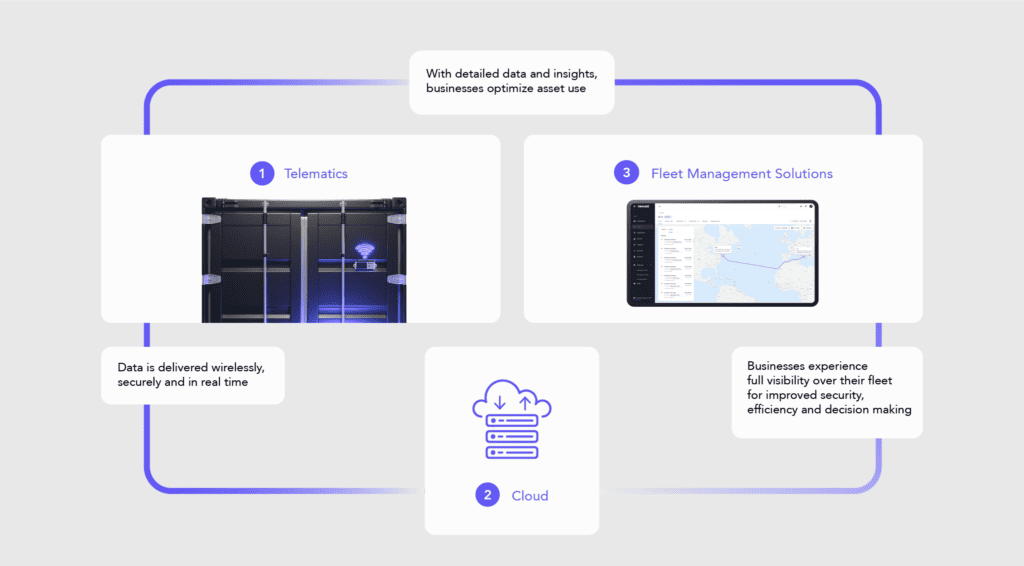While both telematics and fleet management software are often conflated, they do have their differences. Telematics is a system of devices that are mounted on or within containers, railcars or other moving asset for the purpose of transmitting data to a single system. Compared to fleet management software, telematics appeared earlier, around the 1960s, as a technology used to collect and transmit fleet GPS and diagnostics data.
Fleet management software is best understood in partnership with telematics. Fleet management software receives the data provided by telematics and presents it to a single application. In general, it could be understood as an extension of telematics as it provides much more operational data by aggregating information about the entire fleet, providing real-time alerts and notifications, and building a database that makes analyzing performance easier.
Telematics and fleet management solutions both support the tracking and optimization of transport operations. Implementing telematics and fleet management software in a synchronous system nets the greatest benefit by improving fleet management capabilities.
What is telematics?
Telematics is the practice of using devices on vehicles, railcars and shipping containers to transmit data about usage and behavior. Each telematics device sends data points one of two ways. The first is by using the vehicle’s onboard diagnostics (ODBII) or CAN-BUS connector with the traffic usually being routed through a wireless network. Current generation telematics devices connect directly via GSM chip to a wireless network, making data transfers more efficient.
How has telematics evolved in its tracking capabilities?
In early use, telematics devices focused primarily on GPS tracking systems. Now, telematics devices have surpassed basic coordinate tracking and are able to provide detailed reporting and alerts about status and movement. Such data may include information about movement (e.g., idling, acceleration, average speed, etc.), fuel consumption, and risky or specific driving behavior.
As such, current-generation fleet telematics systems enable companies to improve fleet efficiency while reducing operating costs through clear and actionable insights being delivered in real time. Without fleet management software, however, all of that information that’s gleaned from fleet telematics solutions would be scattered and difficult to make use of.
What is fleet management software?
Telematics mostly transmits a large volume of data from every single moving asset independently. Fleet management software can aggregate all that data into a single place, create alerting and visualizations, display all asset locations, enhance back office monitoring capabilities, and do numerous other things that enhance business efficiency.
In other words, fleet management software works like most other large-scale business management software, such as CRMs, only that it is tailored toward managing vehicles, railcars, shipping containers and other supply chain assets.
These systems provide a database and, usually, a dashboard, both of which create immense informational value. The database brings together data and analytics to support the optimization of routes, improved transport efficiency, emission reduction, and tracking of the need for maintenance.
How has fleet management software evolved in its fleet management capabilities?
Dashboards provided by fleet management software, on the other hand, will offer insight into real-time events. One of the most common uses is setting up real-time alerts based on shock, geolocation markers, temperature and humidity fluctuations and more, enabling fleet managers to react as quickly as possible. Additionally, dashboards are frequently used to monitor the movement of vehicles or supply chain assets to predict changes in arrival times.
As such, a fleet management system has the capability to become the primary analytical tool for any company involved with logistics. Implementing innovative telematics for fleet management purposes is only one step of the equation – collecting and sending the data. Dashboards bring this data together, make sense of it, and display it clearly so companies can make better decisions, share important information with clients and ensure safer and more efficient operations.
Today, fleet management software provides better insights, decision-making, and logistical solutions due to the ubiquity of telematics devices. Advancements in the field of telematics have helped fleet management systems as devices now provide not only more data but also significantly more types of information, allowing businesses with analytics departments to get an edge against the competition.
Combining telematics and fleet management software
When combining telematics with a fleet management solution it’s important to understand their reliance on each other. More specifically, data from telematics devices is only useful when it is extracted and shared through fleet management solutions in a timely way and with insights that can be actioned by relevant stakeholders.Databases can only become valuable if the data stored within them is accurate, timely, and actionable.

When combined, both systems provide new opportunities for businesses. For example, dispatching specific transport assets, finding availability, and managing the overall flow of business is all made easier by having timely data that are transmitted onto a screen with clear indications.
A well-integrated fleet management solution simply enhances all of the capabilities provided by the telematics devices. A few of the specific benefits include:
- Real-time visibility of the entire fleet
- Large-scale data acquisition about business logistics
- Better forecasting capabilities for arrival times
- Route and driving optimization
Conclusion
Fleet management has moved away from simple telematics devices that are integrated onto moving assets and checked after they’ve travelled some distance. Next-generation telematics are capable of transmitting data typically gathered manually while adding various new metrics that make fleet management more optimized, safer, and more sustainable.
Nexxiot’s Edge gateway can be enhanced with additional sensors and empowers businesses through real-time monitoring of temperature, humidity, CO2 levels, and dozens of other data points.
Next-generation telematics shines most when integrated with an advanced fleet management solution that can take all of the transmitted data and automatically integrate it into a database and dashboard.

